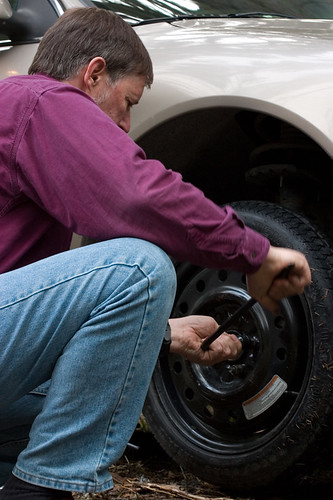Slow leaks, punctures, pinch cuts, blow outs are some types that causes a flat tire. In slow leaks, the tube in the tire must be replaced as it would be difficult to find the tear. Punctures are caused by sharp objects and generally the tear is patched up. Pinch cuts, caused by sharp edges, usually result in a dent in the rim. Blow outs are sudden let-off of air that is usually accompanied by a loud noise.
The first thing that you should do soon after realizing that you have a flat tire is to park the car in a safe place and turn on the parking lights. It would help if the emergency brake is on. It is best to park on a flat surface, as it would help in preventing the car from rolling once you wedge it up. To make matters easy, it is necessary that you possess a spare tire, a jack and a lug wrench.

Remove the flat tire first. To do this, you need to remove the hubcap with the help of a screwdriver or the flat end of a lug wrench. It makes the job much easier if there is no hubcap as some wheels do not need one. The hexagonal bolts in the hubcap, also known as lug nuts, can be removed using the lug wrench. The trick is to turn the lug wrench counter-clockwise if the lug nut has an R inscribed on it. If it has L, instead, then turn it clockwise. It is important that you loosen the lug nuts and not remove them altogether.
Lift the car up with the help of the jack. Pump the jack until the flat tire is totally off the ground. Now, you can remove the lugs that were loosened earlier.
Place the spare tire in position and make sure that the holes of the tires are in sync with the lug bolts. You can now tighten the bolts in the opposite direction that you used to remove them. Now remove all the wheel blocks that were placed to keep the car from moving.



No comments:
Post a Comment